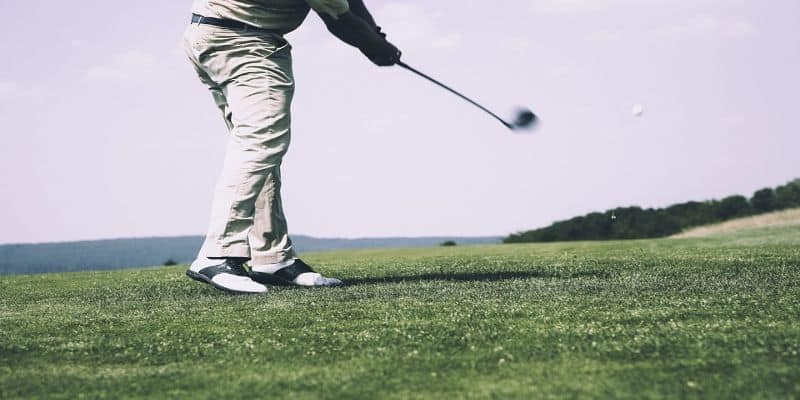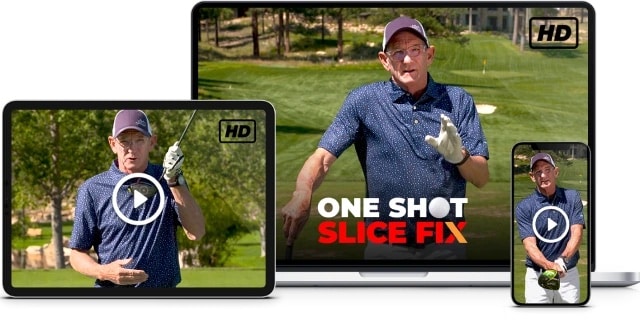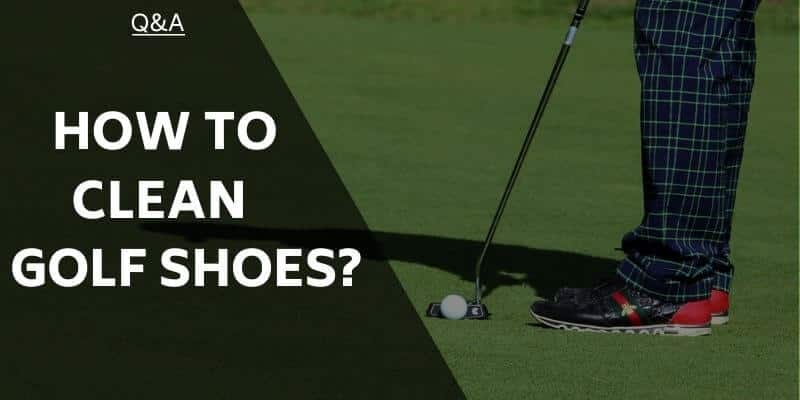It’s the worst sight for any golfer. You hit your ball with lots of hope for a straight, accurate shot. But then it happens. You watch as your golf ball veers violently off to the left. Or to the right. Far far away from the green.
These two shots are known as a hook and slice in golf and must be exterminated immediately.
In this detailed guide on a golf slice vs hook, you will learn that an open or closed clubface at impact prompts these wayward shots. My mission is to explain what they are and why golfers produce them, followed by tips to fix them.
Before you dive into the post, save our guide on playing better golf to help you lower your handicap this year.
What is a Slice?

A slice in golf occurs when the ball curves viciously to the right of the target for right-handed players.
There are three types of slice shots:
- The standard: Starts on line before drifting right away from the mark.
- The pull: Starts left of the target before turning to the right, making it the least drastic of the three.
- The push slice: Starts right off the target and veers further away from the intended landing zone.
Now that you understand the flight of this shot, let’s assess what causes you to propel your ball off target.
Causes of A Slice In Golf (For Right-Handed Golfers)
You can read our guide on how to stop a golf slice for a detailed account of the process. However, you can learn a brief overview of how you combat this dreaded shot.
Loose Grip
You can acquire all the game improvement equipment on the market to improve your game, but nothing aids like an optimal grip setup. A loose grip is a significant reason golfers slice the ball. Due to the lack of control, you struggle to manipulate the face for a square position at contact.
Although it is less common, some players, myself included, slice the ball when our grips are super strong. It is known as the grip of death because it creates enhanced arm tension and prevents you from producing an outside downswing. Instead, you bring the golf club inside and slice across the ball to deliver a right flying shot.
Outside-In Swing Path
Your grip impacts your club path on the back and downswing, which is why you require maximum control. However, when you operate with a weak grip, you relinquish the ability to get the club into the required positions during your swing.
Many amateurs take the golf club along an outside path before sending the club inside on the downswing. This angle causes the clubface to cut across the ball and send it flying to the right of the target.
Forward Ball Position
The correct ball position is vital for every shot because it can restrict your ability to keep your body and clubface in position for impact. I find that the average golfer places their ball too far forward in the stance, which is a sure way to produce a slice.
Because of the ball position, golfers open their shoulders wider than necessary, which sends your clubface along an outside path. You will find that your clubface remains open at impact and travels from inside to out, which is the recipe for a push slice.
Read our guide on the benefits of standing closer to the ball for optimal positioning at send.
Lack Of Rotation
Aside from grip and ball position struggles, an area where amateurs are notoriously bad is hip and shoulder rotation. Your shoulders and hips should ideally be open 45 degrees to the target at impact for enhanced power and accuracy.
However, if you fail to produce sufficient rotation, your hips and shoulder remain in the incorrect position at contact, which affects your clubface and shot shape. I notice countless amateurs keeping their shoulders and hips square at impact, leading to an open clubface and the ball catapulting far right of the target.
How to Fix a Slice
Neutral Grip
A neutral grip setup is the first step to overcoming a slice because it frees your wrists up to bring the clubface square at contact, prompting straighter shots.
A weak grip sees you staring down your right adductor pollicis, the muscle between your thumb and index finger. With this grip, you cannot see any fingers on your hand. You must firm your grip by rotating the right hand anti-clockwise until the gap between your index and thumb creates a v-shape on the shaft.
Be careful not to rotate too much. Otherwise, your right hand will fit underneath the handle and create a super tight hold, restricting your control.
Move The Ball Back In Your Stance
Since forward ball position can cause a slice, you need to move it back in your stance by an inch or two. This will help you stay in posture and sets you up for a clean strike with a square clubface.
If you move it too far back, you risk producing a steep angle of attack and hooking your golf shot.
Inside At The Top Of The Backswing
For straighter golf shots, you want to encourage an inside-out golf swing. In other words, you take the club back and inside before releasing it on an outwards path to the golf ball. This swing path reduces the risk of a slice, which you may experience if you send it inside on a steep angle of attack.
The gradual descent of an inside-to-out golf swing gives you additional time to square your clubface at impact and start the ball on the intended line.
Open Shoulders And Hips To The Target
This final fix optimizes your compression at impact for rapid ball speed and elevated distance. It is vital to produce optimal hip and shoulder rotation during the swing, to keep your club on path, and generate high compression.
Golf coach Clay Ballard suggests that you should have your shoulder, hips, and rib cage open to the target by 45 degrees. However, a 2019 report by Golf Digest noted that amateurs average 30 degrees of rotation by the time they are through impact.
If you can increase that number closer to the 45-degree mark, you will enjoy superior accuracy and distance.
Want More Help Fixing Your Slice? Check Out One Of Our Favorite Courses
One Shot Slice Fix
Hank Haney’s One Shot Fix offers a straightforward, focused approach to tackling one of golf’s most common problems: the dreaded slice. Built around the mechanics of wrist action during your downswing, the program aims to correct your clubface angle, helping you achieve a more targeted and controlled ball flight.
The positives include its simplicity, offering immediate improvements for some golfers, and a comprehensive look at grip, body alignment, swing path, and even equipment. The one notable downside is the program’s “one-shot fix” claim, which might be a bit ambitious for some golfers. While it’s not a universal cure-all, Haney’s method provides valuable insights and techniques for those looking to quickly address their slice issues.
What is a Hook?

A hook golf shot is when a right-handed golfer hits a ball that curves aggressively to the left. For left-handed golfers, it is when the ball curves aggressively to the right.
A hook stems from an improper grip and swing flaws. You’ll notice it is aggravated when you swing on an inside-out line and leave the face closed at impact. There are two types of hooks, a pull, and a snap. Neither is pretty, but a snap hook takes the prize as the nastier of the two.
A pull hook occurs when you swing too far inside the line on your backswing. The position restricts you from freeing up your arms on the downswing to square up the face leading into impact.
In addition, a snap hook is prompted by an exaggerated outwards backswing to the right of your target. You bring the clubface down closed to the path and send your ball directly left.
Causes of A Hook In Golf (For Right-Handed Golfers)
Strong Grip
Opposite of a slice in golf, the first culprit in a hook shot is a strong grip. You’ll find that this setup generates immense arm tension, restricting your flexibility during the swing. As a result, your stiff right arm prompts the club to turn over at impact and close excessively, prompting a golf hook shot.
Backward Ball Position
The second difference between hook and slice shots is the ball position. When you slice, the ball may sit excessively forward in your stance, but a backward setup more likely causes hooks.
If the ball is too far back in your stance, it forces you to attack it from a steep angle, which provides little time for you to bring the clubface into position. In addition, this steep angle causes you to cut across the ball on an outside path, prompting right to left side spin and a disastrous hook.
How to Fix a Hook
Our friends at Golf Digest have some advice on fixing a hook, which you can bookmark for later. For now. Let’s keep going with the reasons you hook your ball.
Neutral Grip
I have already covered the optimal position for a neutral grip, which you can refer to above. However, to shift from a strong to a neutral grip, you must rotate your hands anti-clockwise until the slot between your thumb and index finger makes a v-shape on the rubber.
Avoid excess clockwise rotation because it could weaken your grip and cause slices.
Move The Ball Forward In Your Stance
A difference between slice and hook shots is the ball position. You already know that if your ball is too far forward, it can cause you to slice your shot, but if it is too far back, you can hook your shots.
Therefore, I suggest moving the ball slightly forward in your setup to give you time to shallow the shaft and square your clubface at impact.
Shallow The Golf Club
If you struggle with a steep angle of attack and are striking the golf ball too early on the downswing, consider shallowing the club. Lower your right elbow at the top of the swing as if you were yanking a chain. This will shallow out the club. Next, ensure you optimize rotation on the downswing.
This will help you remain on plane, generate exceptional power, and optimize accuracy. Love him or not, Sergio Garcia is a shining example of how to execute this task thoroughly. Watch him in the below video as he lets loose.
Open Shoulders And Hips To The Target
Several differences exist between a hook vs slice, but there is one constant, rotation. Exceptional hip and shoulder turn is required to execute a powerful, accurate inside-out downswing. Following this path gives you time to get the clubface, hips, and shoulders square to the target for a long, straight golf shot.
What is Better to Have – A Slice or a Hook (of course, neither..!)?
A slice and a hook are both not great, but some wonder if it is better to have one than the other. While some may argue that one is better than the other, that is just not the case.
Both a slice and a hook are not ideal for your golf game, and those consistently producing these shots need to visit a coach. Otherwise, you will endure long, frustrating days on the links, questioning your future as an amateur.
After working with your instructor, hit the range and work on the fixes they provided. That is the only way you will gain control of your shots for consistent results. If you are just starting out, I suggest bookmarking our post on how to swing a golf club to learn the basic mechanics.
What Shots Should You Want Besides a Slice or Hook?
A hook or slice has no business in your golf game, and you must develop the ability to induce a controlled draw, fade, or straight shot. The optimal shape depends on your ability and the objective of the shot.
For example, a high handicapper should focus on straight flight to improve current accuracy. At this stage, there is no reason to get fancy, keep it straight and true, and stay in play. However, lower handicappers should possess the skill to play all three shots for maximum control around the golf course.
When you can produce a draw or fade, it allows you to be aggressive and attack the golf course. You’ll find that you can remove hazards and obstacles from your path by playing one of these shots, which limits the damage, should the result fall below expectations.
Keep expanding your golfing knowledge with our robust library of resources. Bookmark our post on different types of golf shots to expand your repertoire.
Best Products To Eliminate A Hook And Slice In Golf
SKLZ Grip Trainer
Earlier, I touched on the importance of your grip setup in prompting straighter golf shots to keep you in play. My favorite training aid for accurate results is the SKLZ Grip Trainer. You can purchase all the game improvement equipment on earth, but if your grip is a mess, you will struggle forever.
Fortunately, the SKLZ trains you to apply optimal pressure and helps you identify the ideal setup for your swing. The training aid aims to help you build muscle memory, ensuring you grip the club the same way for every swing. Plus, it is built to align the v’s on your grip with your collarbone.
You’ll find it attaches easily to every club in your bag except a putter, and it is compact to carry around. Finally, the SKLZ Grip Trainer is affordable and a wise tool for every amateur to employ on the driving range.
Pros
- Affordable
- Builds muscle memory
- Aligns your v-shape with your collarbone
- Helps you release the club on the downswing to square at impact
- Attaches to every club except your putter
Cons
- Durability
- Lifespan
EyeLine Golf Speed Trap
Turning our attention to the EyeLine Golf Speed Trap, we find a more sophisticated device to
refine the position of your clubface at impact. In addition, it promotes clean ball striking for greater compression and distance.
The training aid includes four-speed rods to guide your clubface into impact. It may feel uncomfortable, but the aim is to help you keep your club on path throughout the swing without touching the speed rods. Using the Speed Trap consistently in practice will help you master your swing path and plane for improved consistency.
You’ll notice that the positioning of the rods trains you to strike the golf ball before the turf for greater compression and less sweeping. If you hit the surface before the ball, you will know all about it from the sound off the polycarbonate base. Finally, EyeLine constructed this aid to work for both left and right-hand golfers.
Pros
- Helps you square your clubface at impact
- Trains you to enhance compression
- Performs for left and right-handed golfers
- Promotes consistent a consistent path and plane
- Reduces your desire to sweep the ball off the turf
Cons
- Expensive for a swing training aid
- You may find the speed rods off-putting during your swing.
Champkey Premium Impact Mat 1.0
The Champkey Premium Impact mat is a simple training aid designed to display your club path leading into impact. It works for two aspects of your game, clean ball striking, and accuracy.
After every shot, you can see where the sole of your club struck the velvet mat, then make the necessary changes to your swing. You can correct these errors by following our steps above, depending on the challenge.
Champkey created a robust impact mat with four layers, led by the velvet-covered top layer. You will notice that the velvet is supported by an ant-tear layer and a shock-absorbing rubber foam. Finally, the Premium Impact Mat 1.0 is built on a rubber backing to ensure maximum stability at impact.
Pros
- Durable
- Instant feedback on your path into impact
- Shows if your clubface was square, closed or open to the target
- Anti-slip rubber backing
- Shock-absorbing rubber foam
Cons
- Moderately expensive for a training aid
- You need to brush the mat after every shot, which becomes tedious.
Golf Slice vs Hook FAQ
Is It Better To Have a Hook or Slice?
No golfer should ask this question because it is better to have neither. There is no winner between a slice vs hook shot because they are dreadful creations that keep you out of play, increase frustration and make you despise the game of golf.
Why Does a Hook Go Further Than a Slice?
A hook goes further than a slice because you typically strike the ball with a closed, delofted clubface. Therefore, you produce less spin and higher compression with a hook, which may see it travel farther.
What Swing Path Causes a Hook?
An inside-to-out swing path can lead to a hook if your clubface shuts closed at impact. You will find that it sends your golf ball left of your target for an inaccurate result.
Why Am I Slicing My Driver And Not My 3 Wood?
The first reason you are slicing your driver and not your 3 wood likely boils down to the ball position. You know your ball should sit forward in your stance, but you are overdoing it to compensate for the added shaft length.
Since your golf ball is excessively forward, you may open your shoulders wider to the target than necessary, causing an open clubface and a slice.
Do Anti Slice Golf Tees Work?
In my experience, anti-slice tees do lower slice sidespin, but they do not eradicate the shape from your game. You will still slice your shots, but the ramifications are reduced to give you a fighting chance on your next shot.
How Is A Golf Hook Vs Slice Different For Left Handers?
The only difference between a slice vs hook golf shot for left-handers is the direction the ball travels. For example, a slice travels from right to left while a hook curves from left to right.
What Is The Difference Between A Slice Vs Draw?
A slice and draw are two vastly different shots. A draw is a controlled shot that curves gently from right to left for right-handers. Conversely, a slice is a vicious shot that starts right of your target and curves further right leading to a challenging position for your next shot.
Final Thoughts
Fixing your slice or hook is a marathon process, but with enough hard work and coaching, you will be hitting great shots in no time.
I recommend considering a training aid to help you practice with a purpose when your coach is not by your side. If grip strength continues to be your kryptonite, I suggest considering the SKLZ Grip Trainer.
However, if you are satisfied with your hold on the golf club and still produce erratic shots, a swing path trainer like the EyeLine Golf Speed Trap is worth a look.
Whatever you do, visit a professional and eradicate these shots the moment they arise. They are cancer on your golf game because it worsens the longer it is left alone. Get it checked out immediately, and eradicate this nasty habit from your game.
Read More:
Nick is the founder of GolfSpan and an avid golfer. He's not quite a pro but has over 15 years of experience playing and coaching golfers worldwide. His mission is to bring the golfing community a better experience when it comes to choosing the right golf gear and finding the right setup for your game.







